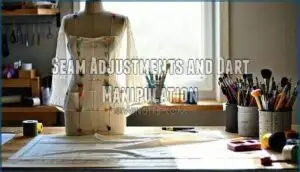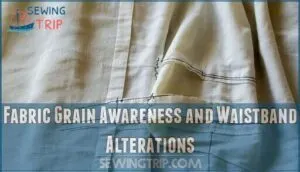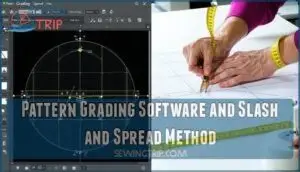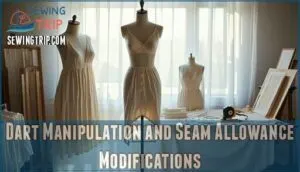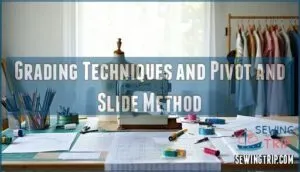This site is supported by our readers. We may earn a commission, at no cost to you, if you purchase through links.

Websites like Pattern Review and Craftsy offer step-by-step guides for common adjustments like shortening sleeves, taking in waistbands, and repositioning darts.
Reddit’s r/sewing community provides real-time troubleshooting when you’re stuck, and many independent pattern designers share alteration techniques on their blogs, covering everything from basic hemming to advanced grading methods.
These resources beat expensive tailoring classes and give you the freedom to perfect your fit at your own pace, with the key lying in knowing which specific techniques work best for different fabric types and garment styles.
Table Of Contents
Key Takeaways
- You’ll find comprehensive free pattern alteration resources through YouTube tutorials, sewing blogs like Pattern Review and Craftsy, and Reddit’s r/sewing community that provide real-time troubleshooting and step-by-step guides for everything from basic hemming to advanced grading methods.
- You can master essential alteration techniques like seam adjustments, dart manipulation, and fabric grain awareness by understanding how different fabric types behave and selecting the right thread and needle combinations for lasting, professional results.
- You’ll achieve perfect fit through advanced customization methods including the slash-and-spread technique, pivot and slide method, and pattern grading software that transform basic patterns into custom-fitted garments without expensive tailoring classes.
- You can build your alteration skills systematically by starting with simple adjustments like shortening hems, practicing on scrap fabric first, and gradually progressing to complex modifications while using online communities for support and step-by-step guides.
Free Online Pattern Help
You’ll find thousands of free pattern alteration resources online, from YouTube tutorials to downloadable guides that walk you through every adjustment step.
Master professional alterations from home with expert tutorials that cost nothing but deliver everything.
These platforms offer expert instruction without the cost, making it easy to master techniques like seam adjustments, dart manipulation, and hemming from your own workspace.
Cropping Jeans for Raw Edge Look
You’ll discover that cropping jeans for a raw edge finish creates an effortlessly cool look without traditional hemming.
This DIY clothing adjustment gives you complete control over jean length options while embracing distressing denim trends. Achieving this look is a cost-effective fashion choice.
Follow these free alteration tutorials steps:
- Measure twice – Try on jeans with intended shoes
- Mark precisely – Use chalk for straight cutting lines
- Cut cleanly – Sharp scissors prevent uneven edges
- Enhance fraying – Gentle wash accelerates the raw edge styling process
Choosing Right Fabric for Alterations
Your fabric choice makes or breaks your alteration project. Fabric compatibility determines whether your modifications will last or fall apart after one wash.
Understanding fabric weight, stretch factor, and drape quality prevents costly mistakes. For unique projects, consider exploring various specialty fabric options.
| Fabric Type | Best For | Stretch Factor | Alteration Durability |
|---|---|---|---|
| Cotton | Basic alterations | Low | High |
| Knits | Fitted garments | High | Medium |
| Denim | Structural changes | None | Very High |
| Silk | Delicate adjustments | Low | Low |
Match your fabric knowledge to your project’s needs for lasting results.
Thread and Needle Selection
You’ll need matching thread types for your fabric compatibility – cotton thread for cotton fabrics, polyester for synthetics.
Needle sizes matter too: use 9-11 for lightweight materials, 14-16 for heavy fabrics.
Your sewing machine’s tension settings affect stitch quality, so test on scraps first.
You can find various cotton options for your sewing needs.
Proper thread selection and needle selection prevent puckering and guarantee professional results.
Sewing Skills Enhancement
Building solid sewing skills sets you up for alteration success. Master machine threading first—it’s like learning to tie your shoes before running a marathon. You’ll thread your machine countless times, so nail this basic step.
Hand stitching comes next, giving you control for delicate work that machines can’t handle. Learn to identify different seam types by examining your clothes. French seams, flat-fell seams, and serged edges each serve specific purposes.
Understanding these helps you match techniques to your project needs. Measuring accurately makes or breaks alterations. Use a flexible tape measure and take measurements over fitted clothing. Poor measurements lead to disappointing results, no matter how skilled your stitching becomes.
Study garment construction by taking apart old clothes. See how pieces connect, where darts shape curves, and how seams create structure. Proper tension is critical; adjust it properly to avoid puckering. Free sewing advice online reinforces these fundamentals through sewing tutorials that build confidence systematically, leading to successful alterations and improved skills.
Pattern Alteration Techniques
You’ll discover that pattern alteration techniques transform ill-fitting garments into custom pieces that flatter your body shape perfectly.
These essential skills include adjusting seams, manipulating darts, and understanding fabric grain to create professional-quality alterations at home.
Seam Adjustments and Dart Manipulation
Perfect seam adjustments and dart manipulation transform ill-fitting patterns into custom masterpieces.
You’ll reshape garments by understanding how darts radiate from pivot points to contour your body’s curves.
Master these pattern modification techniques:
- Pivot method relocates darts without changing overall fit
- Slash-and-spread technique allows precise seam reshaping adjustments
- Professional dart contouring maintains fabric structure while enhancing silhouette
Achieving the perfect fit often requires specialized seam adjustment tools.
Fabric Grain Awareness and Waistband Alterations
Understanding fabric behavior starts with recognizing grainline impact on your alterations.
When you’re working with fabric grain awareness, you’ll notice how the material moves and drapes differently along crosswise versus lengthwise threads.
Waistband resizing becomes smoother when you respect these natural fabric properties.
Straight grain offers minimal stretch.
Free pattern alteration success depends on identifying potential fit issues before they become major alteration challenges, and for more information, you can visit Straight grain.
Panel Inserts and Hemming Techniques
Panel inserts solve tight-fitting problems by adding extra fabric where you need it most.
These strategic additions work alongside professional hemming techniques to create garments that actually fit your body. You’ll find countless free pattern alteration resources online that teach both skills together.
- Insert Fabrics – Choose coordinating or contrasting materials for panel additions
- Hemming Styles – Master straight, curved, and angled hem finishes
- Edge Finishes – Apply serging, pinking, or French seams for durability
- Blind Hems – Create invisible finishes using hand-stitching or machine feet
- Mitered Corners – Perfect 45-degree angles for professional-looking results
Advanced Pattern Customization
You’ve mastered basic alterations, and now it’s time to tackle advanced customization techniques that transform any pattern into your perfect fit.
These professional methods like pattern grading and dart manipulation will give you complete control over garment construction, turning you into your own personal tailor.
Pattern Grading Software and Slash and Spread Method
You’ll discover pattern grading software offers superior software accuracy compared to manual methods, though grading limitations exist with complex designs.
The traditional slash and spread method provides excellent spread applications for simple patterns.
When comparing these approaches through method comparison, software wins for precision while slash variations work better for quick alterations.
Many designers now buy pattern software to streamline their workflow.
Both sewing pattern grading techniques transform your pattern alteration journey.
Dart Manipulation and Seam Allowance Modifications
Your pattern alteration success hinges on mastering dart placement and seam blending for perfect contouring techniques.
Adjust dart positions to enhance curves while maintaining allowance consistency throughout your modifications.
These fit refinement methods transform basic patterns into custom-fitted garments.
Understanding grainline guarantees drape and proper garment flow.
Practice seam adjustments alongside dart manipulation to achieve professional results that’ll make your sewing pattern adjustments look effortless.
Grading Techniques and Pivot and Slide Method
Once you’ve mastered seam adjustments, pattern resizing becomes your next frontier.
The pivot and slide method offers incredible slide benefits for width modifications without cutting pattern pieces.
Unlike complex grading techniques, this approach provides precise method comparison advantages.
You’ll pivot around existing lines for pattern alteration adjustments, making sewing pattern grading accessible, and using pattern alteration techniques.
These pattern alteration techniques transform fitting challenges into simple solutions.
Frequently Asked Questions (FAQs)
Can I make custom alterations to a sewing pattern?
Like a tailor reshaping clay, you can absolutely customize sewing patterns to fit your unique body.
Adjust seams, move darts, lengthen sleeves, or widen waists using basic alteration techniques you’ll master with practice.
How do you alter a sewing pattern?
You’ll measure your body carefully, then adjust the pattern pieces by slashing and spreading for width changes or pivoting for length adjustments.
Mark alterations clearly and test-fit with muslin before cutting your final fabric, ensuring a proper fit.
How do I get accurate alterations?
Measure twice, cut once! You’ll need a flexible tape measure, proper fitting partner, and quality tools.
Take precise body measurements, mark adjustments clearly, and test-fit frequently during alterations for professional results.
This process will help you achieve professional results.
What is online sewing pattern designer?
Online sewing pattern designers are digital tools that create custom patterns based on your measurements.
You’ll input body dimensions, and the software generates downloadable patterns customized to your size and style preferences instantly, using your measurements.
Do I need a toolkit to alter a pattern?
You don’t need a fancy toolkit to start altering patterns.
Basic tools like scissors, measuring tape, pencils, and rulers will get you going.
You can upgrade later as your skills develop, and this is where you can consider fancy tools, but initially, the basics suffice.
How do I modify a pattern?
Think of patterns as puzzle pieces you’re reshaping.
Start by identifying what needs changing—length, width, or curves.
Use the slash-and-spread method to add space or overlap sections to remove it.
Mark changes clearly.
How to alter a pattern for beginners?
Start with simple adjustments like shortening hems or taking in side seams.
Practice on scrap fabric first, then use basic tools like sharp scissors and measuring tape.
YouTube tutorials offer free step-by-step guidance for beginners, providing free instruction.
Is freesewing safe?
Like a trusted friend with scissors, Freesewing operates as an open-source platform that’s completely safe to use.
You’ll find their code transparent, your data stays private, and they don’t store personal measurements.
Is there a site like Ravelry for sewing patterns?
BurdaStyle and PatternReview.com offer similar community features to Ravelry for sewists.
You’ll find pattern databases, user reviews, modification tips, and active forums where crafters share projects and troubleshoot fitting issues together, utilizing community features to enhance their sewing experience.
How to trace a pattern without cutting it out?
Don’t reinvent the wheel – use tracing paper or medical paper over your original pattern.
You’ll create a perfect copy while keeping the master intact.
Simply trace all lines, markings, and notches carefully.
Conclusion
Perfect pattern alteration help online free transforms your sewing journey from frustrating to fulfilling.
You’ve discovered countless resources that’ll help you achieve professional-looking fits without expensive classes.
Whether you’re adjusting darts, grading patterns, or mastering hemming techniques, these online communities and tutorials provide everything you need.
Don’t let ill-fitting garments discourage you—embrace these free tools and watch your confidence grow.
Your perfectly fitted wardrobe is just a few clicks away, waiting for you to start practicing.
- https://www.academia.edu/36600337/Dart_manupulation_method_in_garments
- https://textilelearner.net/dart-manipulation-techniques/
- https://blog.fabrics-store.com/2025/03/06/sewing-essentials-dart-manipulation/
- https://www.longancraft.com/blogs/sewing-tips/dart-manipulation-2-manipulating-methods-for-perfect-fit?srsltid=AfmBOooRyoHhD4dzHwxeSctnRbS-y54u1e4XxJS2oIux1bSpL4fh7t4X
- https://pubs.nmsu.edu/_c/C228/index.html


